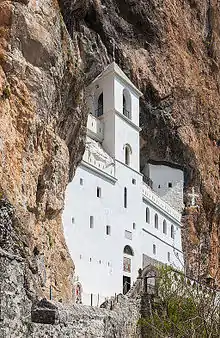Our Lady of Ljeviš
Our Lady of Ljeviš (Serbian: Богородица Љевишка, romanized: Bogorodica Ljeviška; Albanian: Kisha e Shën Premtës) is a 14th-century Serbian Orthodox church in the town of Prizren, in southern Kosovo.[a] Since 2006, the church is part of the UNESCO World Heritage Site named Medieval Monuments in Kosovo.
| Our Lady of Ljeviš | |
|---|---|
 Overview of the church, 1980 | |
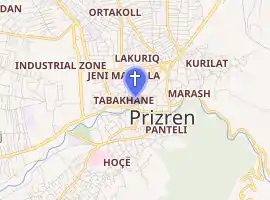
| |
| Location | Prizren, Kosovo[a] |
| Denomination | Serbian Orthodox |
| History | |
| Status | Church[1][2] |
| Founded | 1306–1307 |
| Founder(s) | Stephen Milutin |
| Dedication | Dormition of the Mother of God[3] |
| Architecture | |
| Functional status | Semi-active[1] |
| Style | Serbo-Byzantine style[4] |
| Administration | |
| Diocese | Eparchy of Raška and Prizren[2] |
| Part of | Medieval Monuments in Kosovo |
| Criteria | Cultural: ii, iii, iv |
| Reference | 724-003bis |
| Inscription | 2006 (30th session) |
| Endangered | 2006– |
| Type | Monument of Culture of Exceptional Importance |
| Designated | 1990 |
| Reference no. | SK 1369[5] |
In the beginning of the 14th century it was built during the reign of Stefan Milutin, King of Serbia, on the site of a former Byzantine church. The rebuilt church featured frescoes by Byzantine Greek painters, Michael and Eutychios Astrapas. After the Ottomans completed its annexation of the region in the 15th century, a minaret was erected and the complex was converted into a mosque. In 1912, when the Serbian army annexed Kosovo, the status of the church was restored. After World War II, under SFR Yugoslavia, it saw extensive restoration and reconstruction and functioned as a museum. The site was heavily damaged during the 2004 unrest in Kosovo and has been going through several phases of restoration since then.
Name
Bogorodica Ljeviska was the official name in Milutin's era although the church was popularly known as the Church of St. Friday.[6] This is the name by which it is known by both Albanians as Shën Premte and Serbs as Sveta Petka. Consequently, when it became a mosque it was known Cuma Cami (Albanian: Xhuma Xhami, Serbian: Џума-џамија, romanized: Džuma-džamija[1]), the Friday Mosque, although it was officially known as Fatih Cami, Mehmed Fatih's mosque.
"Ljeviška" (of Ljeviš) is a Serbianized version of the Greek word "Eleusa" (Ελεούσα), meaning "merciful", a type of depiction of the Virgin Mary in icons in which the infant Jesus Christ is nestled against her cheek.[7]
History
The site has been used as a religious and burial site since antiquity. Remains of an altar of the Roman era have been found in the outer walls of the later church. A stone slab which depicts a laurel wreath has also been found within the walls of the church. It may have been part of a public building of the same era in the region of Prizren. These findings are common of medieval times, as parts of older buildings were frequently used as building materials (spolia). They highlight valuable information about the city of Prizren in the Roman period and indicate that it may have been a settlement bigger than a village at that time.[8]
Stefan Milutin, King of Serbia commissioned its rebuilding and expansion in 1306/7 on the site of a Byzantine basilica of the 11th century.[9][10] The Byzantine church had three naves to which Milutin added two more. The architecture of the rebuilt church utilized Late Byzantine architecture through the use of five domes, monumental inscriptions in its exterior and the Byzantine belfry. Milutin chose to utilize these elements as a symbol in order to highlight his own partially Byzantine origin and relation to the imperial family.[10] Another aspect of the frescoes of Bogorodica is their depiction of Orthodox councils as a symbol that referred to the challenges the Orthodox Church faced against the Catholic Church, a situation common in the borderlands between Catholicism and Orthodoxy in the Balkans.[11]
In the 15th century, Prizren became part of the expanding Ottoman Empire. In 1455, Sultan Mehmed the Conqueror (Fatih Mehmet) visited Prizren, which at the time had eight Orthodox and two Catholic churches. Sultan Mehmed chose Bogorodica to become a mosque. An inscription in the church describes the event of the conversion.[12] The conversion into a mosque saw the erection of a minaret, which was removed in 1923 after Serbia had annexed Kosovo. In this period, it was formally called Fatih camisi, while popularly it was known as Cuma Cami, which is how the site is known to the local inhabitants.[13] The archival records of the mosque are a valuable source for the history of Ottoman Prizren. In the Great Turkish War, the Austrian army held Prizren briefly. As a plague erupted, imperial general Silvio Piccolomini visited Prizren to meet Catholic Archbishop Pjetër Bogdani. There, a few days later he died as he had contracted the plague and was buried in the graveyard of the church.[6]
In 1948, it was recognized by the Yugoslav government as a protected cultural site and in 1950-52 a large-scale reconstruction and restoration project began. When it was completed, the site was turned into a museum. Further restoration work was done in the 1970s and 1980s.[14] In 1990, Serbia designated it a Monument of Culture of Exceptional Importance. After the Kosovo War, the complex was guarded by KFOR. It was heavily damaged during the 2004 unrest in Kosovo when it was burnt along with other Serbian Orthodox sites.[15][16] On 13 July 2006, it was placed on UNESCO's World Heritage List as an extension of the Visoki Dečani site (named Medieval Monuments in Kosovo), which, as a whole, was placed on the List of World Heritage in Danger. In 2005-2008, it was restored by the Commission for Implementation of Reconstruction for Serbian Orthodox Church monuments in Kosovo of the European Union. The site is part of the protected cultural heritage of the Kosovo under its Ministry of Culture.[14] In 2020, conservation and restoration of the exterior and churchyard was carried out, under finance Serbian Ministry of Culture and Information after authorization was secured from local institutions.[17]
Gallery
 Bell tower.
Bell tower. St. Barbara
St. Barbara Fresco of King Milutin before restoration in Church Our Lady of Ljeviš in Prizren.
Fresco of King Milutin before restoration in Church Our Lady of Ljeviš in Prizren.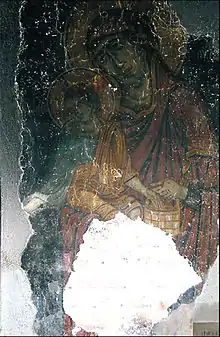 Bathing of the Christ, destroyed during the 2004 unrest in Kosovo.
Bathing of the Christ, destroyed during the 2004 unrest in Kosovo.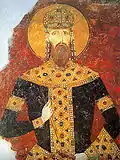 The fresco of King Milutin, Bogorodica Ljeviška.
The fresco of King Milutin, Bogorodica Ljeviška.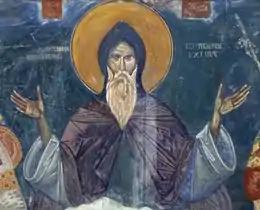 Saint Simeon (Stefan Nemanja), fresco from Mother of God Ljeviška.
Saint Simeon (Stefan Nemanja), fresco from Mother of God Ljeviška. Fresco "Communion of Apostles", Bogorodica Ljeviška.
Fresco "Communion of Apostles", Bogorodica Ljeviška. Stefan Prvovenčani, beginning of the 14th century (1307–1309), fresco from Bogorodica Ljeviška church in Prizren.
Stefan Prvovenčani, beginning of the 14th century (1307–1309), fresco from Bogorodica Ljeviška church in Prizren. Saint Sava, beginning of the 14th century (1307–1309), fresco from Bogorodica Ljeviška church in Prizren.
Saint Sava, beginning of the 14th century (1307–1309), fresco from Bogorodica Ljeviška church in Prizren. View of the church in 2010, after repairs.
View of the church in 2010, after repairs.
Sources
References
- "Bogorodica Ljeviška nije obnovljena ni posle 15 godina od pogroma". Politika. 27 April 2019. Retrieved 25 June 2020.
- Zečević, D. (17 December 2018). "1.000 GODINA EPARHIJE RAŠKO-PRIZRENSKE: Duhovni bedem srpskog naroda". Večernje novosti. Retrieved 25 June 2020.
- "BOGORODICE LJEVIŠKA MOLI BOGA ZA NAS Proslavljena hramovna slava Prizrenske svetinje". Srbin.info. 30 August 2017. Retrieved 25 June 2020.
- The Serbo-Byzantine style, found mainly in the areas conquered from Byzantium, became more widespread in the reign of King Milutin. [...] The fine churches of Bogorodica Ljeviška and Gračanica, both in Kosovo, were built in this style.Bobot, Rajko (1985). Socialist Republic of Serbia. Jugoslovenska Revija. p. 39.
- "Црква Богородице Љевишке". Central Register of the Immovable Cultural Heritage. Retrieved 25 June 2020.
- Nenadović 1963, p. 268
- Otašević, Dušan (2017). Serbian Artistic Heritage in Kosovo and Metohija: Identity, Significance, Vulnerability. Belgrade: Serbian Academy of Sciences and Arts. p. 184. ISBN 978-86-7025-753-5. Archived from [file:///C:/Users/Vanja/Downloads/Serbian_artistic_heritage_in_Kosovo_and.pdf the original] Check
|url=value (help) (PDF) on 2013-08-12. Retrieved 2020-12-24. - Brugmann 2006, p. 15.
- Ćurčić 2005, p. 23.
- Ćurčić 2004, p. 70
- Boeck 2015, p. 140.
- İğciler 2004, p. 23-24.
- Kaleshi 1987, p. 231.
- "Database of Cultural Heritage of Kosovo". Ministry of Culture of the Republic of Kosovo.
- "Prizren, OUR LADY OF LJEVIS (XIV century) - burnt inside (PHOTO: 22.3.2004) - Serbian Orthodox Church [Official web site]".
- "Eighth anniversary of violence against KiM Serbs/OrthoChristian.Com". pravoslavie.ru. Retrieved July 29, 2018.
- "Завршена санација и конзервација звоника на цркви Богородице Љевишке у Призрену". Politika Online. Retrieved 2020-06-18.
Крајем 2019. и почетком 2020. године изведени су припремни радови, а како су локалне власти сагласност за извођење радова на цркви издале средином јануара 2020. године, реализација је померена за пролеће текуће године.
Bibliography
- Boeck, Elena (2015). Imagining the Byzantine Past: The Perception of History in the Illustrated Manuscripts of Skylitzes and Manasses. Cambridge University Press. ISBN 978-1107085817.
- Ferrari, Silvio; Benzo, Andrea (2014). Between Cultural Diversity and Common Heritage: Legal and Religious Perspectives on the Sacred Places of the Mediterranean. London & New York: Routledge.
- Todić, Branislav (1999). Serbian Medieval Painting: The Age of King Milutin. Belgrade: Draganić.
- Brugmann, Birte (2006). "An archeological map of the historic zone of Prizren" (PDF). CHWB.
- Kaleshi, Hasan (1987). "The Oldest Vakuf Charter in Yugoslavia". Revue de philologie orientale. 36.
- Ćurčić, Slobodan (2004). Byzantium: Faith and Power (1261-1557). Metropolitan Museum of Art of New York. ISBN 1588391132.
- Ćurčić, Slobodan (2005). Judson J. Emerick (ed.). "Renewed from the Very Foundations": The Question of the Genesis of the Bogorodica Ljeviska in Prizren. Archaeology in architecture: studies in honor of Cecil L. Striker. von Zabern. ISBN 9783805334921. Retrieved 26 November 2012.
- Nenadović, Slobodan (1963). Bogorodica Ljevis̆ka: njen postanak i njeno mesto u arhitekturi Milutinovog vremena. Narodna knjiga.
- İğciler, Ahmet (2004). Prizren'de yok olan Osmanlı izleri. Kosova Türk Araştırmacılar Derneği.
Notes
| a. | ^ Kosovo is the subject of a territorial dispute between the Republic of Kosovo and the Republic of Serbia. The Republic of Kosovo unilaterally declared independence on 17 February 2008. Serbia continues to claim it as part of its own sovereign territory. The two governments began to normalise relations in 2013, as part of the 2013 Brussels Agreement. Kosovo is currently recognized as an independent state by 99 out of the 193 United Nations member states. In total, 113 UN member states recognized Kosovo at some point, of which 14 later withdrew their recognition. |
External links
| Wikimedia Commons has media related to Bogorodica Ljeviška. |

